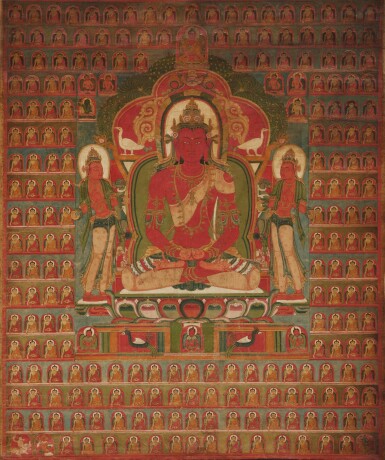Indian and Himalayan Art, including Masterpieces from the Nyingjei Lam Collection
Indian and Himalayan Art, including Masterpieces from the Nyingjei Lam Collection

Property of a European Private Collector
A thangka of Amitabha with myriad Buddhas, Central Tibet, 14th century
Auction Closed
March 21, 04:25 PM GMT
Estimate
40,000 - 60,000 USD
Lot Details
Description
A thangka of Amitabha with myriad Buddhas
Central Tibet, 14th century
藏中 十四世紀 阿彌陀佛及萬佛唐卡
distemper on cloth
Himalayan Art Resources item no. 58527
設色布本
HAR編號58527
Height 32¼ in., 82 cm; Width 26¾ in., 68 cm
Sebastiano Barbagallo, London, late 1980s/early 1990s.
Rubin Museum of Art, New York, 2013-2018 (on loan).
The painting depicts the Transcendental Buddha, Amitabha, red in color, with hands folded in dhyana mudra and legs crossed in vajraparyankasana. The Buddha is seated on an eastern Indian-style throne. Attendant bodhisattvas stand on either side of the throne, both orange in color, with hands in the teaching gesture. The background of the painting is filled with repeated images of Shakyamuni Buddha.
A similar composition of myriad Buddhas is seen on a circa 1250-1300 central Tibetan thangka of Akshobhya Buddha that depicts one of the four Lokapala and two of the eight Dikpala guardians in the lower register, exhibited in Himalayas: An Aesthetic Adventure, Art Institute of Chicago, Chicago, 2003. cat. no. 134. In this catalogue, Pratapaditya Pal suggests that the remaining six Dikpala and three Lokapala that are not depicted on the Akshobhya would appear on other thangkas in a set of five paintings representing a Vajradhatu mandala, ibid., p. 207. Indeed, Akshobhya's mandala position is East and the Lokapala depicted in the lower register, Dhritarashtra, is the Guardian of the East, while the present thangka of Amitabha, whose mandala position is West, depicts the Guardian of the West, Virupaksha. Pal further suggests that the central painting of the group of five, that of Vairochana, would not depict guardians: indeed, a late thirteenth or early fourteenth century central Tibetan 'Vairochana' thangka from a set of five, with similar myriad Buddha composition, contains no guardian deities, as shown in The Circle of Bliss: Buddhist Meditational Art, Columbus Museum of Art, Columbus, 2003, cat. no. 131. The myriad Buddhas depicted on all these paintings likely represent the concept of the Thousand Buddhas of the Auspicious Aeon (see Pal, op. cit.).
The present Amitabha would thus have been one of the five paintings in an important set of thangkas representing a Vajradhatu mandala, a popular iconographic theme in early Tibetan art. Amitabha's face expresses an otherworldly intensity reminiscent of medieval eastern Indian sculpture and painting. Compare a late thirteenth or early fourteenth century central Tibetan thangka of Amitabha painted in the eastern Indian manner, exhibited in Kossak and Casey Singer, Sacred Visions: Early Paintings from Central Tibet, The Metropolitan Museum of Art, New York, 1999, cat. no. 28; and the miniature Buddha figures depicted on the diaphanous shawl of a circa 1200-1250 painting of Ratnasambhava, ibid., cat. no. 23. See also another 14th century Central Tibetan thangka of Amitabha with similar iconography from the same collection, sold in these rooms, 20th September 2022, lot 111.
